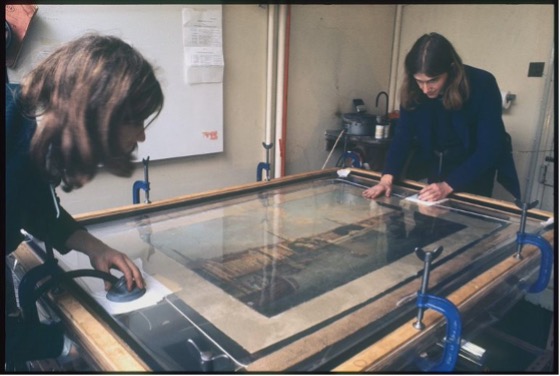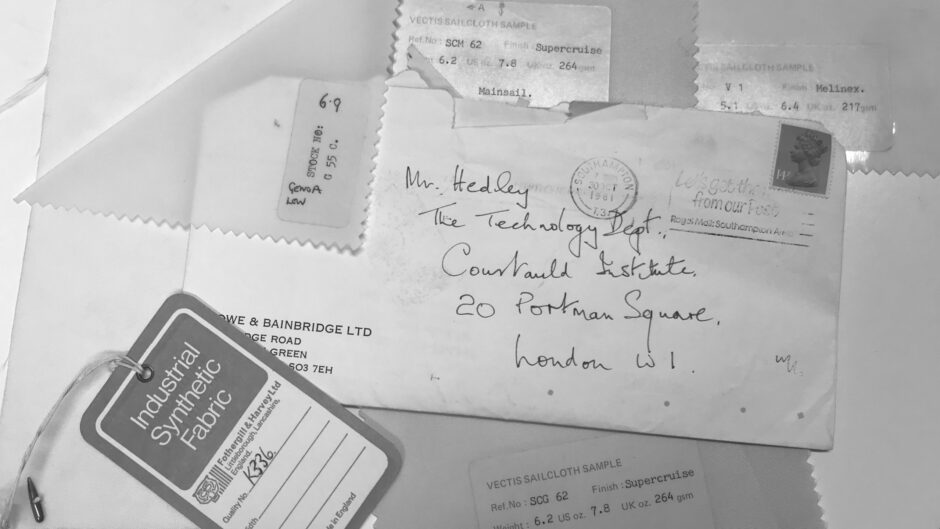Overview
From the 1960s and 1970s onwards, The Courtauld Institute of Art and Royal Museums Greenwich (RMG) worked together at the forefront of developments in lining methods for paintings. Westby Percival-Prescott, Head of the Paintings Conservation Department at RMG from 1961-83, worked closely with Stephen Rees Jones and Gerry Hedley from The Courtauld to adopt the innovative methods developed there, including the use of a vacuum hot table and vacuum envelope for lining. Over a number of years, the two institutions worked in partnership to re-assess the way paintings were commonly lined and form a new philosophy on lining which held ethical decision-making and a minimalist approach at its heart. It was partly because of this friendship that Percival-Prescott proposed the first conference solely focused on the structural conservation of canvas supports: the ‘Comparative Lining Techniques’ conference, which was held at Greenwich in 1974. The research delivered at this conference, such as Percival-Prescott’s key-note speech ‘The Lining Cycle’ would influence many of the conservators in attendance and would inform contemporary attitudes to lining for years to come.
As part of the Getty Foundation’s ‘Conserving Canvas Initiative’ launched in 2018, a fresh period of collaboration between the RMG and the Courtauld became possible. Conservators from both institutions came together once again to design a project which would not only recover and re-examine the institutions’ joint history but also inform future collection care.
For an explanation of the lining process and what it involves, follow this link to the RMG website. What does ‘lining’ a painting mean? | Royal Museums Greenwich (rmg.co.uk)

Primary Aims
The primary aims of the ‘Conserving Canvas’ project between The Courtauld and RMG were:
- to explore the history of canvas structural treatments between 1970–1990 at both partner institutions by examining the archival materials held at the RMG and The Courtauld and by interviewing participants of the Greenwich lining conference and former conservators who had been involved with either institution.
- to produce a survey on the condition of modern linings performed during the 1970–1990 period, with the goal being to gather information on the longevity of these linings and especially those carried out with modern adhesives.
- to promote further dissemination of learning and the development of practical skills in the structural conservation of canvas, benefitting the wider conservation profession beyond the two institutions themselves.

Masterclasses
A series of four Masterclasses were led by structural experts and attended by conservators from various institutions, such as Tate, English Heritage and National Trust. These Masterclasses culminated in the relining of William Westall’s 1802 ‘View of Cape Townshend’ from the RMG collection by conservator Sarah Maisey with expert support. This widely-disseminated treatment, delivered as the fourth Masterclass, served to generate in-depth discussions about techniques and materials in lining across the wider paintings conservation community. The skills acquired during these Masterclasses will hopefully promote future collaborative lining projects between the two institutions.

Conservation Fellow Camille Polkownik came on board to share her own expertise in lining and delve into the treatment archives at the Courtauld and RMG.
- Camille found that, as a working museum, the RMG focused on developing tried-and-tested lining techniques prior to and following the 1974 Greenwich conference. There was a brief period of experimentation but, as part of a working museum, the RMG conservators had to keep up with the increasing demand of exhibitions and loans. As a result, they focused on fine-tuning their lining process by thoroughly testing a range of materials and then employing these consistently in their practice.
- The Courtauld, on the other hand, was found to have revelled in opportunities for further research and experimentation with regards to testing lining adhesives, fabrics and techniques. The fact that the Courtauld favoured cutting-edge research is reflected by the sheer number and range of materials tested as well as the various specialised research projects conducted over the years.
- The project also served to highlight the impact that the 1974 Greenwich conference had on contemporary attitudes to lining. As Camille reviewed treatment reports from RMG ranging from 1965-2000, the number of linings carried out was found to diminish significantly after 1974, while other minimalist alternatives to lining, such as localised reinforcement, increased.

Learn More
Take a look at some archival shorts from these research projects, including the development of an early lining table and a time-lapse demonstration of how a canvas can react to moisture.
Visit the RMG website to find out more about the project: The Westall Lining Project | Art Conservation in Action (rmg.co.uk)

